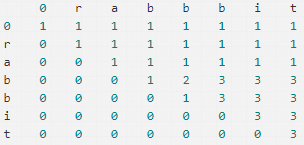题目:
Given a string S and a string T, count the number of distinct subsequences of T in S.
A subsequence of a string is a new string which is formed from the original string by deleting some (can be none) of the characters without disturbing the relative positions of the remaining characters. (ie,"ACE"is a subsequence of"ABCDE"while"AEC"is not).
Here is an example:
S ="rabbbit", T ="rabbit"
Return3.
题意:
翻译过来的很绕口,让人难以理解。我个人的理解就是 删掉S字符串中的某个字符后可以有多少种方法使得S还与T相等。
解题思路:
这时候就需要一张图了(滑稽)图来自于牛客网某位仁兄


有图就好办了。
这题很明显使用动态规划来解决,我们以S.length()来做列,T.length()来做行
动态规划一般有两个难点
第一个难点是如何确定边界,关于边界问题,可由上图得出,当T字符串为空时,所有次数都为1,当S字符串和T字符串都为空时,次数为1,当 S字符串为空,T不为空就全为0 ,好了边界已经确定好了
第二个难点是如何确定动态规划公式
S.charAt(j-1) = T.charAt(i-1)时,可以得出 array[i][j] = array[i][j-1] +array[i-1][j-1];
S.charAt(j-1) != T.charAt(i-1)时 array[i][j] = array[i][j-1]
好了动态规划的公式也得出来了,现在就可以写代码了
需要注意的是:
遍历的时候不要从0开始,不然会出现空指针
i,j可以取到T,S的长度的,不然返回的值就是array数组最开始初始化的值 也就是0
代码如下:
public int numDistinct(String S, String T) {
if(S.length() == 0 && T.length() != 0) {
return 0;
}
int[][] array = new int[T.length()+1][S.length()+1];
//初始化边界
for(int i = 0; i <= S.length(); i++) {
array[0][i] = 1;
}
for(int j = 1; j <= T.length(); j++) {
array[j][0] = 0;
}
for(int i = 1; i <= T.length(); i++) {
for(int j = 1; j <= S.length(); j++) {
if(S.charAt(j-1) == T.charAt(i-1)) {
array[i][j] = array[i][j-1] + array[i-1][j-1];
}
else {
array[i][j] = array[i][j-1];
}
}
}
return array[T.length()][S.length()];
}








 本文介绍了一道经典的动态规划题目——计算字符串S中有多少不同的子序列与字符串T相等。通过详细的解题思路和代码实现,帮助读者理解如何利用动态规划解决这类问题。
本文介绍了一道经典的动态规划题目——计算字符串S中有多少不同的子序列与字符串T相等。通过详细的解题思路和代码实现,帮助读者理解如何利用动态规划解决这类问题。

















 被折叠的 条评论
为什么被折叠?
被折叠的 条评论
为什么被折叠?








